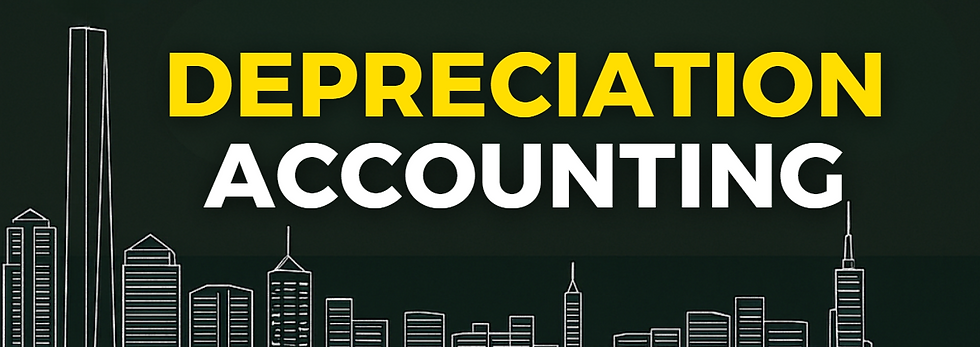DEPRECIATION ACCOUNTING: Methods, Journal Entries, and Financial Reporting
- Graziano Stefanelli
- Jun 9
- 2 min read

Depreciation spreads the cost of a tangible asset over its useful life to match expense with economic benefit.
It affects both the income statement (via expense) and the balance sheet (via accumulated depreciation).
1. What Is Depreciation?
Depreciation is the systematic allocation of an asset’s cost over the periods it is used.
It applies to tangible fixed assets such as:
Machinery
Vehicles
Office equipment
Buildings
Land is not depreciated, as it does not lose value from use.
2. Depreciable Cost and Useful Life
Depreciable base = Cost of asset – Residual (salvage) value
The depreciable base is allocated over the asset’s useful life, which must be estimated based on expected usage, wear and tear, and legal/technical limits.
3. Depreciation Methods
Method | Formula / Key Feature |
Straight-Line | Equal amount each year: (Cost – Salvage) ÷ Useful Life |
Declining Balance | Accelerated method using a fixed % of book value |
Double Declining | 2 × Straight-Line rate applied to book value |
Units of Production | Based on actual usage or output: Cost per unit × Units used |
Example (Straight-Line):
Asset cost = €30,000
Salvage = €3,000
Useful life = 5 years→ Annual depreciation = (€30,000 – €3,000) ÷ 5 = €5,400
4. Journal Entry for Depreciation
Each accounting period:
debit Depreciation Expense
credit Accumulated Depreciation
Example entry:
debit Depreciation Expense ............................ 5,400
credit Accumulated Depreciation .................... 5,400
Accumulated depreciation is a contra-asset account that offsets the asset’s cost on the balance sheet.
5. Mid-Year and Partial-Year Depreciation
If an asset is acquired mid-year, depreciation may be prorated.
Example:
Asset acquired July 1, straight-line method
Annual depreciation: €4,800→ Half-year depreciation in Year 1 = €2,400
Companies may use:
Full-month convention (depreciate for entire month of acquisition)
Half-year convention (assume 6 months regardless of purchase date)
Policies should be applied consistently.
6. Depreciation Schedule Example
Year | Depreciation Expense | Accumulated Depreciation | Net Book Value |
1 | €5,400 | €5,400 | €24,600 |
2 | €5,400 | €10,800 | €19,200 |
3 | €5,400 | €16,200 | €13,800 |
4 | €5,400 | €21,600 | €8,400 |
5 | €5,400 | €27,000 | €3,000 (salvage) |
7. Asset Disposal and Depreciation Stop
Depreciation stops when:
Asset is fully depreciated
Asset is disposed of or sold
Disposal entry includes:
Removing asset cost and accumulated depreciation
Recording cash received
Recognizing gain or loss
8. Depreciation vs Impairment
Aspect | Depreciation | Impairment |
Timing | Planned, recurring | Unexpected, one-time |
Basis | Useful life and residual value | Recoverable amount < carrying value |
Reversal (IFRS only) | Not permitted under US GAAP | Permitted under IFRS if conditions improve |
9. Financial Reporting and Disclosures
Balance Sheet:
Fixed assets shown at cost minus accumulated depreciation
Income Statement:
Annual depreciation expense reported under operating expenses
Cash Flow Statement:
Added back to net income under operating activities (non-cash expense)
Disclosures include:
Depreciation method(s) used
Useful lives or depreciation rates
Total depreciation for the period
Gross and net book value of assets
Key take-aways
Depreciation allocates asset costs over useful life, aligning expense with usage.
Methods like straight-line, declining balance, and units of production affect timing of expense recognition.
Accumulated depreciation tracks total expense to date and reduces the book value.
Consistent policy and accurate estimates ensure reliable financial reporting.
____________
FOLLOW US FOR MORE.
DATA STUDIOS




